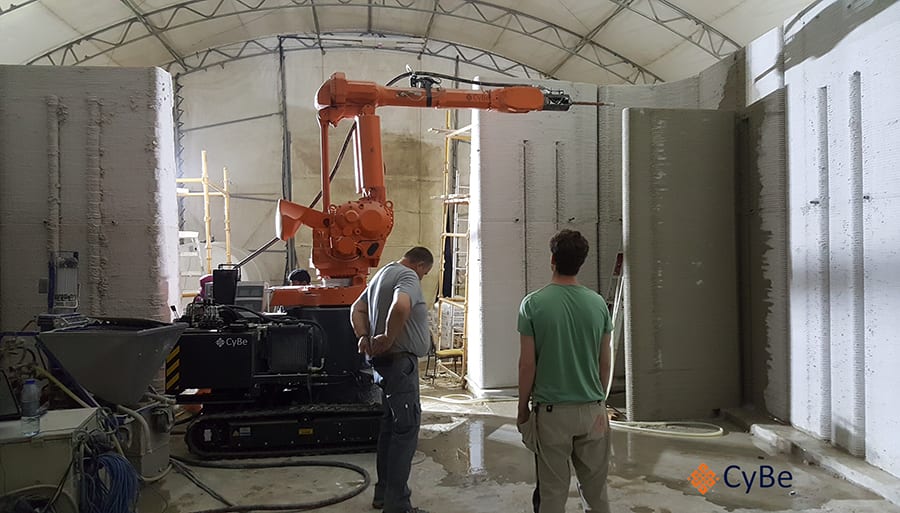One of the world’s most advanced onsite 3D-printed buildings was completed in record time earlier this year, by a team led by Dutch engineering firm CyBe Construction.
The R&Drone Laboratory in Dubai will function as a research hub for drone and 3D printing technologies. It is located in the desert at the Mohammed bin Rashid Al Maktoum Solar Park, the largest single-site solar farm in the world.
CyBe planned then built the 168 sq m single-storey concrete structure in just three weeks, working in collaboration with Dubai Electrical and Water Authority, architect Wanders Wagner, engineering consultant Witteveen + Bos and construction firm Convrgnt.
It comprises 27 separate wall elements and 25 separate parapets, which were printed in just three weeks using a specialist 3D printing robot on caterpillar tracks, known as the CyBe RC 3Dp. The machine is able to print at an average speed of 250mm per second and is controlled via bespoke software plug-ins for Rhino, developed by CyBe.
The walls were printed in separate 2m-wide x 3.75m-high sections, needed to accommodate thermal expansion and shrinkage, then connected together with steel anchors to create a solid monolithic structure.
Weep holes, connections for wall studs and electrical conduits are placed inside each wall elements during printing. The roof is a lightweight hollow core subfloor – one of the few elements that were not 3D printed – capped with 25 concrete parapet elements that were printed inside the tent then craned into position.
Berry Hendriks, founder of CyBe, says: “The original plan was to 3D print the roof, but after discussions with the main contractor and the client we concluded it was not economic as a very costly steel structure would be required to support it.”

When each wall element was complete, the machine was driven to an adjacent position to begin work on the next wall
The printing process for each 2m-wide wall went as follows: the CyBe RC 3Dp was driven manually into position at the edge of the foundation slab and its three legs were anchored to the floor slab for stability. The fast-setting concrete material, known as CyBe MORTAR, was extruded in layers. Each took an hour to cure, while being sprayed with cold water to prevent cracking due to the fast hydration process.
Hendriks comments: “The material is able to achieve 20MPa of compressive strength and 4MPa of flexural strength within 24 hours of printing, and a final set time of only five minutes, which meant the initial layer was quickly able to support loading from the rest of the wall above.”
When each 2m-wide wall element was complete, the machine was driven to an adjacent position to begin work on the next wall.
According to Hendriks, the use of 3D printing reduced the construction time by four weeks, compared to traditional methods, mainly because printing a double-curved structure is much faster than having to install complex formwork.
In terms of cost, the 3D concrete print process becomes more economic when carried out at scale. “Comparatively speaking, if one building were to cost €200, two would cost €300 to build, so by scaling up the process, building gets cheaper very quickly. That’s why we are now starting to look at projects that involve over 10 buildings to achieve the cost and time benefits,” he adds.
Dubai has been leading the charge when it comes to 3D printing. In 2016 prime minister Sheikh Mohammed bin Rashid Al Maktoum announced plans for the country to print 25% of its buildings by 2030, as part of its 3D printing strategy.
He made the announcement at the opening of the first 3D printed office, understood to be created by Winsun Global, the international division of China’s 3D printing pioneer Winsun, in partnership with global architecture firm Gensler among others.













